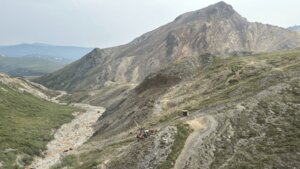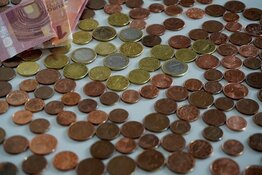The Gold Report: When we talked in the summer, gold had found a floor at around $1,280/ounce ($1,280/oz). Where is the new floor?
Florian Siegfried: With a floor of $1,280/oz in August, the question was will it hold or not. Obviously, it did not. There could be even more downward pressure. The support level could be around $1,070/oz, especially given that the U.S. dollar has more upside. It could take a couple of months before we clear out the weak hands here.
TGR: What's going to bring upward pressure to gold prices in 2015?
FS: We need to see a change in sentiment in the overall markets. In September, equities were going up and the high-yield market was running wild. That was followed by a mini-panic in both equities and the high-yield market in October. Then we had a springboard rally in the equities, which was really substantial, but the high-yield market stopped reaching new highs.
"Asanko Gold Inc. has a lot of leverage to the gold price."
There is a divergence happening now. Not all equities are participating in the uptrend, and there are rising spreads in the yield market. Things are not as robust as they were, which could also support the gold price at these levels. It doesn't confirm a trend yet, but gold is basically an investment that you want to have when liquidity is seeking a safe harbor. There are some small signs in the market that the sentiment is changing.
TGR: In late October, U.S. Federal Reserve Chairman Janet Yellen announced the end of quantitative easing (QE). Did the gold price react the way you thought it would? Could it have been worse?
FS: The Fed officially announced the end of QE, but when we look into the Treasury International Capital (TIC) report, there is a large sovereign entity in Belgium that has become the third-largest holder of U.S. Treasury securities after China and Japan. We don't know who the buyer is, but obviously Russia is dumping Treasury bonds, and with current oil prices the Organization of the Petroleum Exporting Countries (OPEC) has much less capital to recycle into U.S. Treasuries.
It's puzzling to know how ending QE is going to work. Officially, it worked: the dollar went up and gold tanked. The problem is that the Fed is tapering into economic weakness. As a result, my suspicion is that the zero interest rate policy is going to stay, and we will see yet another round of QE. One of these days gold will react to this central-planning recklessness. So far, the market has perceived the Fed's move as a rising-dollar scenario, probably a rising interest rate scenario, too, but I don't see interest rates rising any time soon.
"Victoria Gold Corp. continues to drill and find new zones, like Olive, and has the cash to do just that."
TGR: What's a realistic trading range for gold in 2015?
FS: In a really bearish scenario gold could hit $970/oz. I would say that's the floor. We could see some more downward pressure before the end of the year, but it's difficult to make predictions because basically every market is somehow manipulated and managed. I wouldn't be surprised to see gold at $1,400–1,500/oz in 2015 but if central banks step in and keep pushing equities higher, as they did this year, then $970/oz is more likely. But when this price-fixing scheme comes to an end, there will be some kind of a reversion to the mean for all asset prices.
TGR: In August, you talked about the continued rotation out of broad market equities into precious metals. Would you suggest that the process has stalled?
FS: We had a severe break in equities in October but the rebound has been impressive. That rebound has pushed money back into equity markets and has taken some air out of precious metals. Gold is down in U.S. dollars, but in most other currencies, it's up. In Swiss francs, euros and yen, gold is up year-to-date. Should deflationary pressure mount, I think we could see a continued rotation out of the equity and high yield markets into liquidity, namely short-term government bonds and gold. I think this process has not stalled.
TGR: Do you expect mergers and acquisitions (M&A) to be a major theme in the gold space in 2015?
FS: Yes, definitely. We just saw a "stink bid" from New Gold Inc. (NGD:TSX; NGD:NYSE.MKT) for Bayfield Ventures Corp. (BYV:TSX.V), and the merger between Scorpio Mining Corp. (SPM:TSX) and U.S. Gold and Silver Corp. (USA:TSX; USSIF:OTCQX) in an all-paper deal. I think two types of deals will dominate M&A over the next while. First, midtier producers will buy cheaply valued advanced exploration or development companies at roughly a 50% premium in all-share deals. These deals will not be material to the larger companies—they are essentially buying optionality for their project portfolio, which is smart. This is the time to do so.
The other kind of transaction will be mergers among equals, mostly as acts of desperation. How else will these companies get to the critical mass that excites more shareholders? I doubt most of these deals will create value over time because there will be little operational synergies among these companies.
TGR: Are these all-paper deals the blueprint for future deals?
FS: Yes. Every company that has a decent share price can use shares as a currency without spending valuable cash. Every CEO who is prudent will not use cash for M&A at these prices. As for the target companies, those CEOs are executing a takeover bid from a solid producer, so they get something. They would probably prefer quality shares to cash. That way there is a chance to benefit from the upside once the cycle turns.
TGR: What are some likely takeover targets?
FS: At current valuations, Alacer Gold Corp. (ASR:TSX: AQG:ASX) has a depressed multiple. The company is a low-cost producer with solid margins. In Q3/14 the company produced 63,356 oz at all-in costs of $763/oz at its 80%-owned Çöpler mine in Turkey. What could attract the company to any acquirer is the sulfide portion of the mine that has yet to be built. The sulfide project has a preproduction capital expenditure (capex) of $633 million ($633M) but has a 17-year mine life with all-in costs of $810/oz. That is the kind of project companies are looking for—relatively low capital costs leading to a low-cost, long-life operation. On top of that, Alacer has about $350M cash and no debt. An acquirer could use that cash to build the mine.
TGR: Are companies with polymetallic assets more likely to be targets?
FS: Probably not in the current environment because base metals and iron prices are all down. The trend is down and that is likely to continue. If you are positive on base metals, the dance would be different. But selling those kinds of assets in this market is rather tricky.
TGR: Other targets?
FS: Another one is Amara Mining Plc (AMA:LSE). It has a 5 million ounce (5 Moz) resource called Yaoure in Ivory Coast, West Africa. It's a junior company but with the right ingredients—a solid resource with decent gold grades, a long mine life and low production costs. The projected all-in costs are $624/oz. There are few projects of this kind that can withstand a $1,000 gold price and in this kind of economy Amara is clearly a takeout candidate.
TGR: Amara used to be known as Cluff Gold Plc. What did you make of the recent Yaoure drill results?
FS: The company continues to demonstrate that the project is growing and that the high-grade mineralization has continuity. It will enter the feasibility stage later next year. It's all about derisking the project. At its current market cap ($70M), Amara cannot raise the $500–600M necessary to build this mine.
TGR: Any others?
FS: We discussed Romarco Minerals Inc. (R:TSX) in the last interview. It received a mine-operating permit, and the debt terms for $200M in project finance are in place. The grade is OK. It's in South Carolina, which is fine. Do we see a strategic partner buying into Romarco or Romarco being taken out? Both are possibilities. The project is derisked to a level where it should become an M&A target.
TGR: Romarco just got a loan for $200M but it needs another $120M to build the mine. Where is that going to come from?
FS: That is still subject to equity financing, which is probably holding back the stock because there was a negative reaction when it published the permitting news. Everybody knows an equity deal is coming. So, from an acquirer's standpoint, is it the optimum time to buy? Probably. It's either that or Romarco goes the route of self-financing. But at $0.50 or $0.60 per share it would be quite dilutive.
TGR: When the permitting news reached the market, casual observers like myself thought the price would bump up but the opposite happened. Please explain that further.
FS: If people want to sell in this market, they sell on good news when there is liquidity in the stock. It's puzzling for the average investor, but that is how the market is right now. It provides opportunities if you can buy on the dips because you still get a high-quality asset in a safe jurisdiction, trading at $0.55/share.
TGR: Are there other likely takeover targets?
FS: There is another AIM-listed company called Condor Gold Plc (CNR:LSE). It just released a prefeasibility study (PFS) and updated preliminary economic assessment (PEA) for its La India project in Nicaragua. It has 2.33 Moz at 3.9 grams per ton (3.9 g/t), and that includes 1.14 Moz at 3.1 g/t in an open pit, which is very high these days. Management has skin in the game and holds 9% of the company and it is leanly managed.
With the recent financing, the International Financial Corp. (IFC) entered the picture as a strategic partner. That's a commitment that should help to further reduce political risk. In its PFS, Condor looks at a 0.8 million tons per year (0.8 Mtpa) open-pit mine with an annual production of 79,300 oz gold over seven years considering a front load capex of $110M and all-in sustaining costs of $690/oz. Then in the updated PEA there are two options to build La India. One is to include additional feeder pits for a 1.2 Mtpa plant with a capital requirement of $127M and an annual production of 96,800 oz over a 8-year mine life at similar all-in costs. The other option would include the underground resource, a $170M capex and an annual production of 137,000 oz over a 12-year mine life.
Is it going to be a higher capital cost, higher-production scenario or a lower-capital cost, lower-production scenario? The company wants to be viewed as positively as possible. It is basically saying, "This project has all kinds of optionality, it has strong financing backed by the IFC and it's close to infrastructure." Management gives me the impression that this project is for sale, but not at the current share price.
TGR: Is grade a key theme for you in these takeover deals?
FS: Grade is king at the moment. In the end, you want to own quality companies that can make money at current prices or even if we touch $900/oz gold. Because the market has almost no visibility on where gold prices are heading, everything is concentrated on grade because it protects your margins. Should we move into a higher gold price environment, the best leverage is probably with the current marginal producers. They have no room for error, so their valuations remain extremely depressed. Grade is king, at least for the moment.
TGR: What are some producers that could offset a lower gold price with gains from a weak Canadian or Australian dollar versus the greenback?
FS: I would watch Detour Gold Corp. (DGC:TSX) for two reasons. First, probably 80% of its operating and capital expenses are directly linked to the Canadian dollar. So you benefit from a weaker Canadian dollar. Second is leverage to the oil price in the form of lower diesel costs. Oil is down 20% YTD and you can take advantage by investing in big-scale, open-pit, high-tonnage, low-grade operations because those mines are energy and diesel sensitive. You essentially get a "double whammy" with the lower oil prices and the lower Canadian dollar.
TGR: Will takeover rumors resume on that name in 2015?
FS: Detour is still fine-tuning its operations. The company is not cash flow positive at current prices. But it should be in 2015, assuming gold prices stay where they are or move higher and tonnage increases. If that happens and you're looking for a world-class project in a safe jurisdiction, then Detour should be on the list.
TGR: Any other producers that fit that bill?
FS: Down the food chain is Claude Resources Inc. (CRJ:TSX), a junior trading at about $0.26/share. Its Q3/14 financials were amazing. Its net income of CA$6.9M in Q3/14 was up from CA$3.3M in Q2/14. That's the function of increasing production, higher head grades and a weak Canadian dollar. All three have helped the company remain very profitable even at these depressed prices.
A third one, with a slightly higher production profile compared to Claude, is Richmont Mines Inc. (RIC:TSX; RIC:NYSE.MKT). As with Claude, it also increased its production guidance for 2014 and in Q3/14 it earned CA$4.6M and was also free cash flow positive. It has CA$39M in cash and very little debt. It has the grade, which is around 6.0 g/t at its Island and Beaufor mines, and most of the costs are in Canadian dollars. It's a similar situation to Claude's.
TGR: Are there some development-stage gold projects that haven't seen share prices respond to positive news?
FS: One that really has been beaten down, and we discussed in our last interview, is Victoria Gold Corp. (VIT:TSX.V). The share price is down to $0.10. Nevertheless, its strategy is the right one. The Eagle project in the Yukon is permitted to mine, but Victoria is not willing to accept any kind of financing from, let's say, hungry private equity groups at disadvantageous terms. So the company continues to drill and find new zones, like Olive, and it has the cash to do just that. It's not in a rush to develop Eagle in this market. From a valuation standpoint, Victoria is trading almost at cash. It's in the Yukon so that's a safe jurisdiction, too.
TGR: Is Olive enough to bring investors back?
FS: The grade at Olive is almost double that of Eagle. In my opinion, Victoria should define a resource at Olive. Then when Eagle is three to five years into production and the grade in the mine plan drops, Victoria fills that gap with higher-grade ore from Olive. That would increase the internal rate of return (IRR) because the company would likely need limited additional capital to bring Olive on-line. If Victoria demonstrates it can go that route, Olive could bring investors back. Victoria is like an option on gold without an expiry date.
TGR: Does the company have the right management in place for the current wait-it-out strategy?
FS: Yes, I think so. The management and board have experience in building mines. The other question is: Does Victoria have the operating team in place? It doesn't yet, but it doesn't need to. If it came to a production decision, which I don't see any time soon given its share price and the market conditions, it would have to beef up the operational team.
TGR: Any other updates on companies you mentioned in your last interview?
FS: We discussed Asanko Gold Inc. (AKG:TSX; AKG:NYSE.MKT). Asanko has released an optimized mine plan and associated operating costs for the Asanko gold mine in Ghana. This, together with the previously disclosed capex ($295M) and mineral resource update (reserves of 2.51 Moz at 2.15 g/t gold), builds the company's Definitive Project Plan. The optimized mine plan basically reduces the waste mined, and as a result the strip ratio comes down to 5.3:1, while the sustaining capital has been increased moderately, by approximately $9M. Overall, this confirms the robust project economics based on the very low $781 all-in sustaining costs (AISC) over life of mine. With the recent weakness in the West African gold stocks, the market did not honor these results. [Editor's note: Comment revised on Nov. 28, 2014.]
TGR: Any other companies?
FS: I'm a director of GoldQuest Mining Corp. (GQC:TSX.V). GoldQuest's Romero project has an Indicated resource of 2.38 Moz gold equivalent in the Dominican Republic, but the company isn't getting much love from the market. Basically, there are two issues. One is the $333M it will need to build the mine, which is quite high. And that resulted in a relatively low IRR for Romero. We will have to come up with a strategy to improve the PEA numbers. Can we reduce the upfront capital or is there an opportunity to more quickly mine a high-grade portion of the ore in order to increase the IRR? Some optimization work will have to be done.
Romero is a high-grade deposit with all-in sustaining costs, including byproduct credits, of $350/oz, which is very robust. Otherwise, the 100%-owned Tireo is a big district. It's not cheap to drill and the mineralization appears in clusters. We have money in the bank, and the company will drill test more targets.
TGR: Without naming names, have you signed confidentiality agreements (CAs) with some of the neighboring companies in the Dominican Republic?
FS: Yes, we signed some CAs, but that was done upon the discovery of Romero.
TGR: What are some of the other players in the Dominican Republic?
FS: Barrick Gold Corp. (ABX:TSX; ABX:NYSE) is clearly No. 1. Glencore International Plc (GLEN:LSE)/Xstrata is on the island, too, and then it's mostly juniors like Precipitate Gold Corp. (PRG:TSX.V) and Unigold Inc. (UGD:TSX.V). Newmont Mining Corp. (NEM:NYSE) and Eurasian Minerals Inc. (EMX:TSX.V; EMXX:NYSE) are close to the Dominican border in Haiti, but it is unclear how the efforts to reform the county's mining code will eventually turn out.
TGR: Are there other companies that you're following?
FS: In the silver space First Majestic Silver Corp. (FR:TSX; AG:NYSE; FMV:FSE) is back to its 2008 levels. It should produce 11.5 Moz silver in 2014, but requires a higher silver price to be profitable. If you expect higher silver prices, I think First Majestic offers a good leverage.
Falco Resources Ltd. (FPC:TSX.V) controls the former producing Horne mining camp in Quebec. The company targets a multimillion ounce gold resource and has cash in the bank. Osisko Gold Royalties Ltd. (OR:TSX), which just announced a friendly business combination with project generator Virginia Mines Inc. (VGQ:TSX), holds 12% of Falco Resources.
Dalradian Resources Inc. (DNA:TSX) is developing its high-grade Curraghinalt gold project in Northern Ireland. The project has a robust PEA based on $1,200/oz gold and the company has $37M in the bank.
Then there is a junior named East Africa Metals Inc. (EAM:TSX.V). The market cap is $8M but it has $16M in working capital. The market probably expects that the money will disappear. Exploration is all about value creation through drilling and if East Africa could demonstrate that it will use the cash to drill, then it's worth having a look at. Its main asset is in Ethiopia in East Africa. Interestingly, Qatar-backed QKR Corp. is said to be close to making a $1 billion bid for miner Nevsun Resources Ltd. (NSU:TSX; NSU:NYSE.MKT), which is operating in Eritrea just north of Ethiopia. Probably this will bring back the whole region to the mining and M&A landscape.
TGR: What words of wisdom do you have for investors in the gold space?
FS: I would still play it safe here. Look for producers that make money at these prices to protect your downside risk—as long as those companies have little chance of issuing new shares. Also, have a look at selective exploration and development stocks that have done well this year. A few stocks are up 20–60% YTD based on progress on fundamentals.
I would be reluctant to buy into any company that is high grading at these prices to survive. If companies mine their best deposit at current gold prices at small margins, those firms are basically giving away their upside when the cycle starts to turn upward. I would rather see those companies shut down and wait for better prices.
TGR: Thank you for your insights, Florian.
 Florian Siegfried is head of precious metals and mining investments at AgaNola Ltd., an asset management boutique based in Switzerland. Previously Siegfried was the CEO of Precious Capital AG, a Zurich-based fund specializing in global mining investments. Prior to this Siegfried was CEO of shaPE Capital, a SIX Swiss Exchange-listed private equity company that was founded by Bank Julius Baer & Co. Siegfried holds a masters degree in finance and economics from the University of Zurich.
Florian Siegfried is head of precious metals and mining investments at AgaNola Ltd., an asset management boutique based in Switzerland. Previously Siegfried was the CEO of Precious Capital AG, a Zurich-based fund specializing in global mining investments. Prior to this Siegfried was CEO of shaPE Capital, a SIX Swiss Exchange-listed private equity company that was founded by Bank Julius Baer & Co. Siegfried holds a masters degree in finance and economics from the University of Zurich.
Read what other experts are saying about:
Want to read more Gold Report interviews like this? Sign up for our free e-newsletter, and you'll learn when new articles have been published. To see a list of recent interviews with industry analysts and commentators, visit our Streetwise Interviews page.
DISCLOSURE:
1) Brian Sylvester conducted this interview for Streetwise Reports LLC, publisher of The Gold Report, The Energy Report, The Life Sciences Report and The Mining Report, and provides services to Streetwise Reports as an independent contractor. He owns, or his family owns, shares of the following companies mentioned in this interview: None.
2) The following companies mentioned in the interview are sponsors of Streetwise Reports: Asanko Gold Inc., Unigold Inc., Victoria Gold Corp., Virginia Mines Inc., Richmont Mines Ltd. and Precipitate Gold Corp. The companies mentioned in this interview were not involved in any aspect of the interview preparation or post-interview editing so the expert could speak independently about the sector. Streetwise Reports does not accept stock in exchange for its services.
3) Florian Siegfried: I own, or my family owns, shares of the following companies mentioned in this interview: Alacer Gold Corp., Victoria Gold Corp. and GoldQuest Mine Corp. I personally am, or my family is, paid by the following companies mentioned in this interview: None. My company has a financial relationship with the following companies mentioned in this interview: None. I was not paid by Streetwise Reports for participating in this interview. Comments and opinions expressed are my own comments and opinions. I determined and had final say over which companies would be included in the interview based on my research, understanding of the sector and interview theme. I had the opportunity to review the interview for accuracy as of the date of the interview and am responsible for the content of the interview.
4) Interviews are edited for clarity. Streetwise Reports does not make editorial comments or change experts' statements without their consent.
5) The interview does not constitute investment advice. Each reader is encouraged to consult with his or her individual financial professional and any action a reader takes as a result of information presented here is his or her own responsibility. By opening this page, each reader accepts and agrees to Streetwise Reports' terms of use and full legal disclaimer.
6) From time to time, Streetwise Reports LLC and its directors, officers, employees or members of their families, as well as persons interviewed for articles and interviews on the site, may have a long or short position in securities mentioned. Directors, officers, employees or members of their families are prohibited from making purchases and/or sales of those securities in the open market or otherwise during the up-to-four-week interval from the time of the interview until after it publishes.












































